GermGuardian AC4100 Review
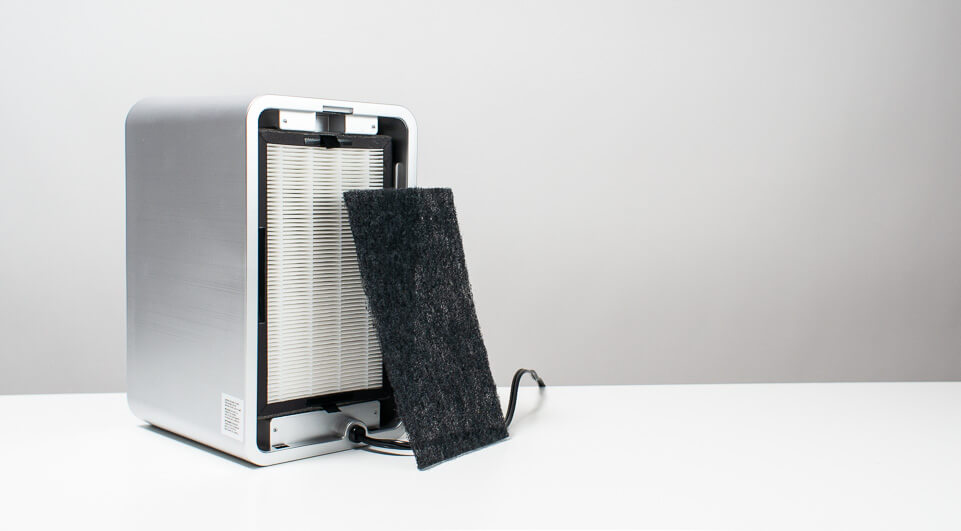
Feature Scores
Pros
- Very small and light weight – highly portable
- Well built – hard exterior metal shell, few buttons, LEDs to break (single knob controls most settings and should last a long time)
- No control panel lights or any lights for that matter that turn on
- True HEPA filter at low price point
Cons
- Carbon filter is very low quality both in terms of durability (tears easily) and overall performance (contains a very low quantity of carbon)
- Low area of coverage – the unit’s approx. 80 CFM of output is only sufficient for rooms under 100 sq. ft.
- Noise output – this unit is almost as loud as much higher CFM units
Editor's Score
Quick Facts
| Particle filter type | HEPA |
|---|---|
| Gas filter type | Carbon |
| Pre-Filter | No separate pre-filter – combination carbon/pre-filter |
| Output | Approx. 80 CFM |
| Air Movement | Front grille > carbon/pre-filter combination filter > HEPA filter |
| Number of fan speeds | 3 |
| Size | 11 in. tall x 6.5 in. wide x 7.5 in. deep |
| Weight | 4.5 lb. |
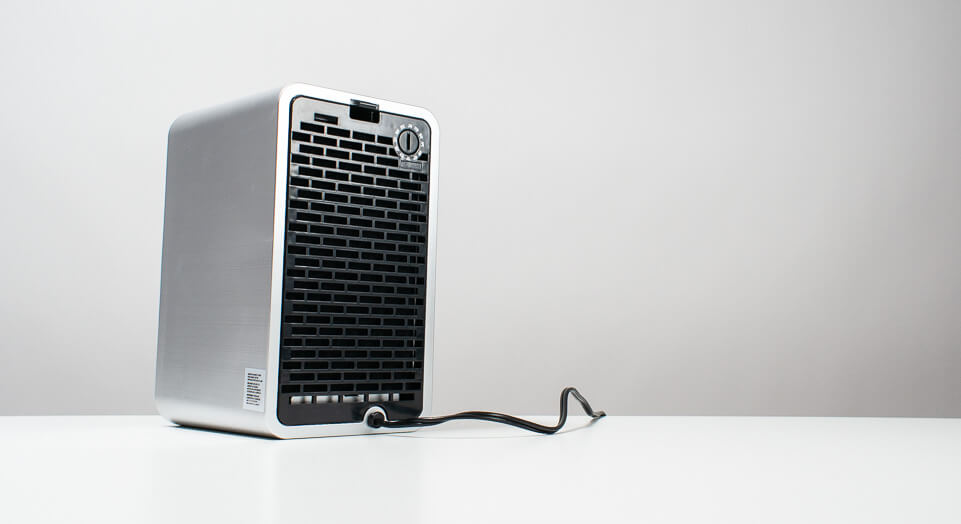



Analysis
A step by step breakdown of the AC4100's performance.
Air Processing Performance
Test Results
In a 150 sq. ft. test environment, the GermGuardian AC4100 lowered room particle concentration from 10,000 particles per cubic ft. down to 3,800 particles per cubic ft. in 44 minutes. After an additional 1 hr. and 6 minutes, it was able to lower room particle concentration down to 3,100 particles per cubic ft. This was the lowest room particle concentration this unit was able to achieve during testing.
For comparison, most other air purifiers we tested were able to lower room particle concentration from 10,000 particles per cubic ft. down to 100 particles per cubic ft. in 15 minutes to an hour. For example, the top rated Winix 5500-2 lowered room particle concentration from 10,000 down to 100 particles per cubic ft. in a total of only 15 minutes. Again, the AC4100 took well over 1 hr. and could only get the room to 3,100 particles per cubic ft.
Note that other “small” air purifiers (with low CFM) we tested garnered similar results (to the AC4100) in our testing. For example, the Levoit LV-H126 also could only get room particle concentration down to the 3,000 to 4,000 particles per cubic ft. range and also took very long to do so.
The bottom line is that the AC4100:
- took a very long time (44 minutes) to lower particle concentration even slightly (from 10,000 down to 3,800 particles per cubic ft.)
- took even longer (an additional 1 hr. 6 minutes) to lower particle concentration to the lowest concentration it was able to achieve (3,100 particles per cubic ft.) and
- even given this additional time, wasn’t able to achieve the same super low level of particle concentration (100 particles per cubic ft.) as most other air purifiers we tested
Filter Analysis
Particle Filter
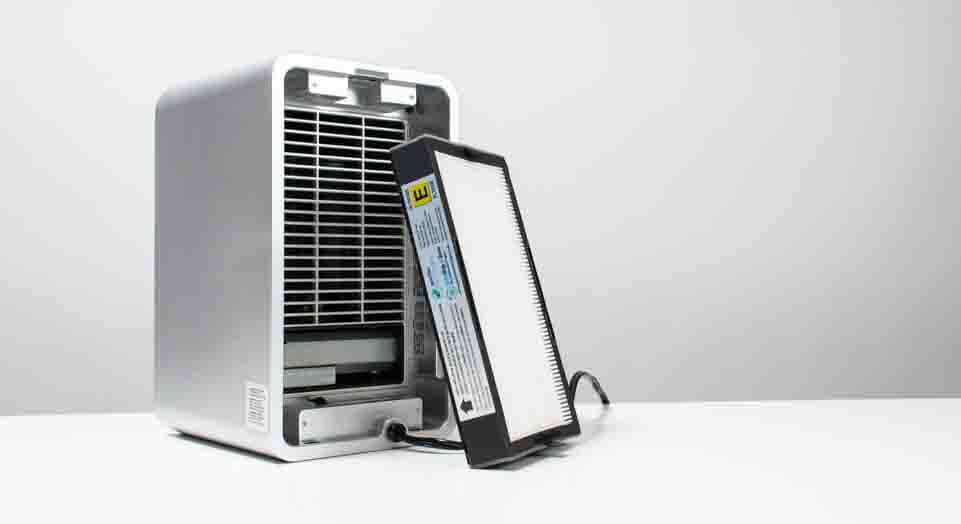
This unit does come equipped with a true (albeit very small) HEPA filter – very impressive for a unit in the price range. HEPA is the industry standard for particle filtration (removing particles like allergens, dust, mold, etc.). Everything from the approx. $150 Winix 5500-2 to the approx. $900 IQAir HealthPro Plus comes equipped with the same type of particle filter - a true HEPA filter.
If the AC4100 comes equipped with the same type of particle filter as units more than 10x its price, why did it perform so poorly in our performance testing? The answer is simple: CFM (the cubic ft. of air it processes every minute). With only 80 CFM (approx.) this unit simply cannot process air fast enough to keep up with a 150 sq. ft. room (the size of our test space). In extremely small spaces (under 100 sq. ft.) it should be able to lower particle concentration to the same extent (to the same super low room particle concentration) as much more expensive air purifiers, although it will still take much longer to do so because of its low CFM.
Note: the LEVOIT LV-H126 also comes equipped with a true HEPA filter.
Gas Filter
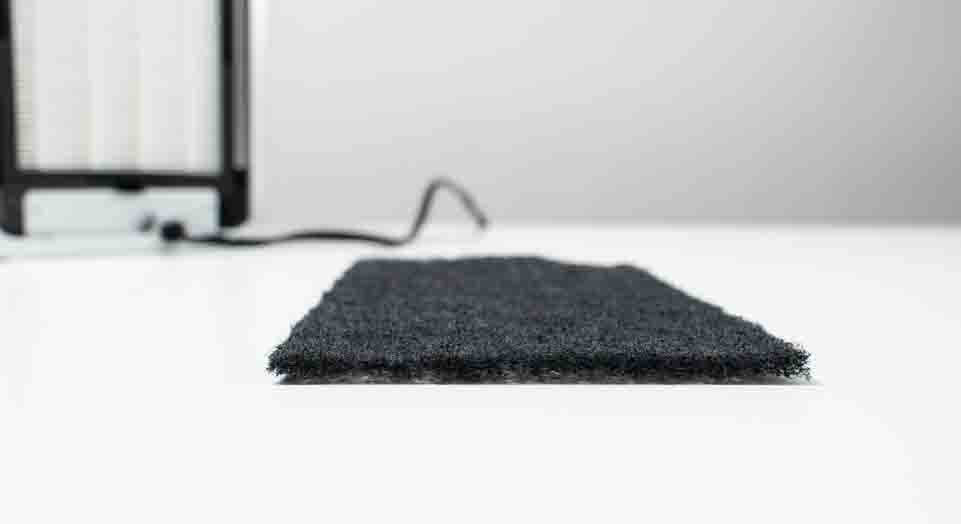
The AC4100 comes equipped with a carbon filter for gas filtration (removing unwanted gases like VOCs and odors). This is the same type of carbon filter you find on much more expensive options (like the the Coway Mighty, for example) – the filter consists of a fibrous material that’s coated with carbon.
If gas filtration is a priority for you then we would recommend going with a unit that has a different type of carbon filter. For example, the Winix 5500-2 comes with a carbon filter that contains actual carbon pellets for the purpose of gas filtration. This type of carbon filter is much more effective for removing unwanted gases than the fibrous carbon coated type of filter installed in the AC4100.
It would be remiss of us not to note the fact that the AC4100 does have the same type of carbon filter as more expensive options (like the Coway Mighty) but the actual quality of the filter is much lower. During testing, fibers would actually tear off of the filter when we removed it from the Velcro holding it in place in the AC4100. The fibers of the AC4100’s carbon filter are much fewer and much more spread apart than they are in carbon filters for more expensive options. Fewer and more spread apart fibers equates to fewer fibers coated with carbon which itself equates to less carbon for gas filtration and lower overall gas filtration quality.
Pre-filter
The AC4100 does not come equipped with a separate dedicated pre-filter. The carbon filter has the task of filtering gases (the usual task of a carbon filter) AND filtering large particles (the usual task for a pre-filter).
This is problematic for a few different reasons. First of all, gas filtration quality is reduced as the carbon filter saturates with large particles. The large particles cover up areas of the filter that would otherwise be able to adsorb gases. Second, the carbon filter has to be replaced when it saturates with large particles. This may happen before it would have saturated with gases. And when it does saturate, the filter has to be replaced at cost (it’s not washable).
In more expensive air purifiers, there’s usually a separate dedicated pre-filter. Both the Winix 5500-2 and Coway Mighty come equipped with such a pre-filter. This type of pre-filter is comprised of a fine mesh that can be washed when it clogs up with large particles. The pre-filter can be washed over and over again for the life of the air purifier. It never has to be replaced at cost.
Note that the AC4100’s lack of a separate washable pre-filter is not uncommon in its price range. The very popular AC4825 (approx. $80) has the same setup – a single fibrous carbon filter that has to filter gases and large particles. So does the Levoit LV-H126 (approx. $60), Honeywell HPA100 (approx. $100), and many others.
Is this type of pre-filter a deal breaker? No, not for most users. But be aware that long term costs are increased because of it (you have to replace a filter at cost when it saturates with large particles vs simply having to wash it).
UV
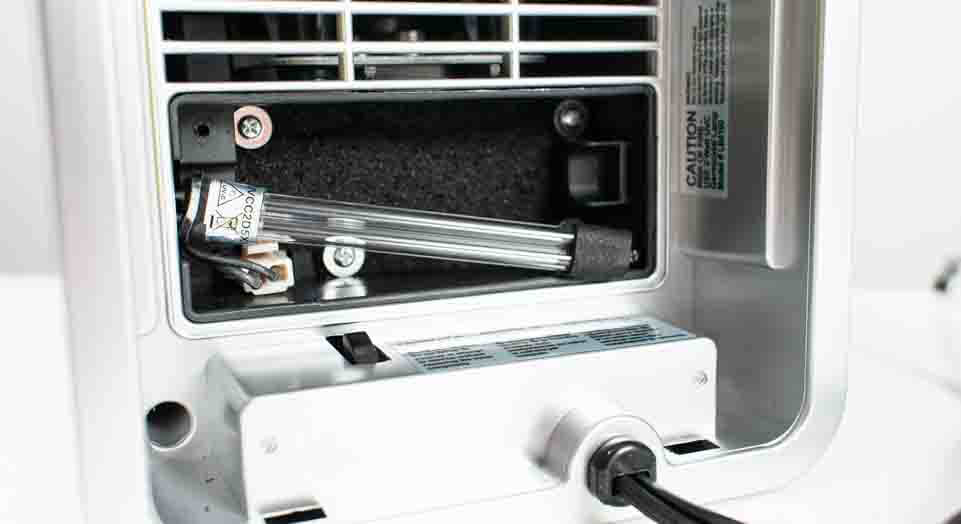
The AC4100 does come equipped with UV functionality but it is very poorly implemented. First of all, the bulb used for UV is only 2 watts. Second, its situated behind a metal bracket at the very bottom of the air purifier. We’re not even sure how any UV light makes contact with any air that moves through the air purifier.
The bottom line – do not buy this air purifier for its UV functionality. The good news though: you don’t need to kill germs to filter them from the air. This unit will do just fine removing germs from the air in very small rooms with its HEPA filter. It doesn’t need to kill them to remove them from the air.
Air Movement
The AC4100’s approx. 80 CFM (cubic ft. of air processing per minute) is only sufficient for rooms less than 100 sq. ft. This unit will not work effectively in larger rooms.
Will it be able to put a dent in particle concentration in larger rooms? Yes, it absolutely will. But if your ultimate goal is to completely clean the air in a room (i.e. remove almost all particles from the air in a room) this unit will only be able to get you part of the way there in larger rooms and it will take very long to even do that. It will only be able to completely clean the air and do so in a reasonable time frame in a room smaller than 100 sq. ft.
Note that you cannot place this air purifier directly in front of you on a desk or directly next to you in your bed and expect it to blow completely cleaned air onto you. Air just doesn’t work that way. As soon as cleaned air exits this (or any other) air purifier it immediately distributes throughout the whole room. “Dirty” air from areas of higher particle concentration in the room immediately swoops in to even everything out (particle diffusion is the scientific term for this process).
There is no such thing as a “clean air bubble” being created around the air purifier. The air purifier lowers particle concentration slowly but surely in the whole room. This is why it’s so important to “seal” the room (by closing doors and windows) to limit the volume of air that’s being cleaned.
For comparison, top rated 250 CFM units like the Winix 5500-2 and Coway Mighty can be used in rooms up to 300 sq. ft. The approx. 140 CFM AC4825 can be used in rooms up to 150 sq. ft. And the Levoit LV-H126 also has very low CFM like the AC4100 so it can also only be used in rooms less than 100 sq. ft.
Energy Efficiency
The AC4100 has slightly below average energy efficiency but overall power draw is very low. In other words, this unit is not very energy efficient but it doesn’t draw a lot of power to begin with, so its less than stellar energy efficiency really isn’t that big of a problem.
We evaluate energy efficiency based on the unit’s CFM/watt ratio. The higher the ratio – the more CFM per watt used – the better the energy efficiency.
The AC4100’s overall power draw varies between about 25 and 36 watts, depending on fan speed (higher fan speeds draw more power). Its CFM/watt ratio is in the 2 to 3 range – approx. 2 to 3 CFM per watt of power draw.
For comparison, the only other super small air purifier we’ve tested so far, the Levoit LV-H126, had even worse ratios – in the 1 to 2 CFM per watt range. Top rated larger air purifiers like the Winix 5500-2 and Coway Mighty have much better ratios.
These larger units are so energy efficient that they draw even less power than the AC4100 on low fan speeds – less than 10 watts of power. Even at this low of a power draw they still have greater output (CFM) than the AC4100 on these low fan speeds. With less power draw and even higher CFM, these units have extremely high CFM/watt ratios and are therefore much more energy efficient than the AC4100. CFM/watt ratios range between 10 and 20 for both the Coway and Winix on lower fan speeds. On higher fan speeds ratios are in the 3 to 5 range with a total power draw in the 60 to 70 watt range.
Noise Output
The AC4100, much like most other small air purifiers we tested, did not do very well in noise output testing. On high fan speed, its raw dB number isn’t too bad – we measured it at 63.7 dB. This is actually less than the 66.1 dB of a larger unit in the Coway Mighty and the 67.5 dB of the Winix 5500-2. However, both the Coway and Winix have much greater output (CFM) at these dB levels so their CFM/dB ratios are much better.
Things don’t get much better for the AC4100 on lower fan speeds. On its lowest fan speed, specifically, it was measured at 57.4 dB. This is as quiet as this air purifier gets – 57.4 dB – and it’s just not very quiet. For comparison, the Levoit LV-H126 produces only approx. 40 dB of noise on its lowest fan speed. So does the Coway and Winix. Most air purifiers we tested could be set to a low fan speed where they’re essentially “whisper quiet”. The AC4100 has no such setting.
Things get even worse for the AC4100 when you compare its CFM and dB levels on its highest output vs. the CFM and dB levels of top rated units at lower outputs. Again, the AC4100 was measured at 63.7 dB on its highest fan speed at approx. 80 CFM of output. The Coway and Winix both output at approx. 100 to 120 CFM on their second highest fan speed. On this setting they were each measured at 48.9 dB. Thus, you have 63.7 dB at approx. 80 CFM with the AC4100 and you have 48.9 dB at approx. 100 to 120 CFM with the Coway and Winix. It should be clear from this evaluation which is the better option if low noise output is a priority for you.
Durability
The AC4100 is very well built for its price. The unit is housed in a metal shell with a metal front grille. This metal is much more durable than the plastic shell housing of most other air purifiers on the market. Even the top rated Coway Mighty and Winix 5500-2 have plastic shells.
Furthermore, the AC4100 has a single knob that controls most settings – turning the unit on/off and setting fan speed. There’s a button for UV activation but you’re unlikely to use it because UV implementation is so poor.
The only real downside in terms of durability for this unit is the fact that you have to stick small plastic feet to the bottom of the unit when you unbox it. The plastic feet are pressed onto the bottom of the unit like stickers and they stay in place on the bottom of the unit like stickers (with a glue holding them in place). On the positive side of things, you don’t have to “install” them. You can easily use the air purifier without it having these plastic feet.
Ease of Use
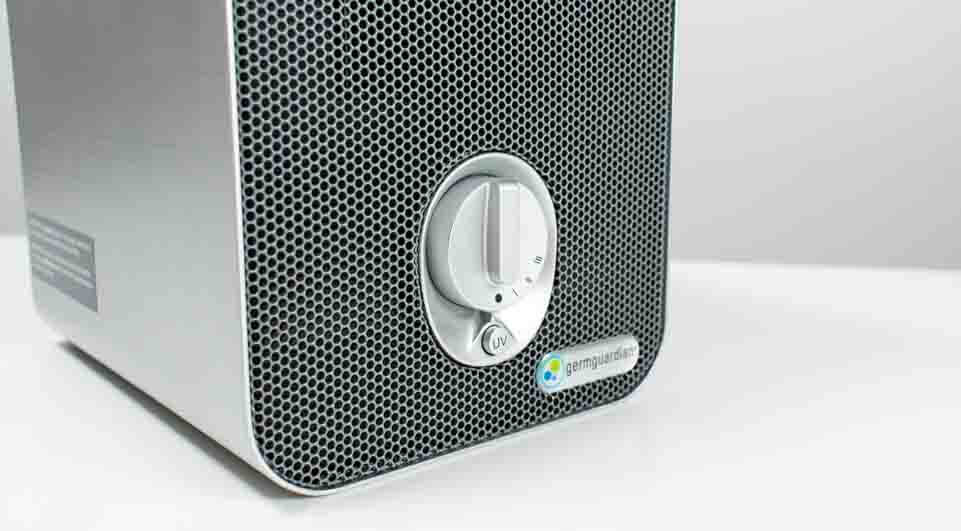
Because of its very basic controls there’s no illumination on this air purifier. That is to say, there’s no LEDs that illuminate when you turn it on or set it to different fan speeds. If it did have LEDs that illuminated this could be problematic for some users that are sensitive to light sources in a dark room during night time use. This is in fact a problem when operating most other air purifiers on the market.
Most other air purifiers have control panel LEDs that illuminate which makes night time use in dark rooms problematic for some users. Even top rated units like the Winix 5500-2 and Coway Mighty have control panel LEDs that cannot be turned off. The AC4100 and also the Levoit LV-H126 were part of a group of very few air purifiers we tested that have control panel LEDs that are either not there to begin with or can be turned completely off.
The AC4100 is highly portable. It’s physically small and reasonably light – only about 5 lb. even with its metal shell exterior.
This unit does lack certain common features. It does not come with a timer, for example. Most other air purifiers on the market do come with a timer. Many have an auto mode, a sleep mode, an air quality meter, etc. This unit has none of those features.
Although it’s not as common of a feature, this unit also lacks a remote control. It also lacks smart functionality.
Value
The GermGuardian AC4100 is a very inexpensive air purifier. It usually retails for approx. $60. The very popular approx. 140 CFM GermGuardian AC4825 retails for approx. $80. Top rated 250 CFM units like the Coway Mighty and Winix 5500-2 retail for between $150 and $200.
Filter replacements for this unit are usually approx. $20. The AC4825’s filter set costs approx. $25 and filter replacement kits for the Coway and Winix are approx. $40 to $60. Note that filters for the AC4825 and especially the Coway and Winix are much larger and factoring in their larger surface area and the greater number of particles they’re able to remove from the air because of it, what you get for what you pay for all of these units is actually very similar in terms of value. Yes, you will pay less for filter replacements for the AC4100 but you also get much less filter (in terms of surface area) for that lower cost. Conversely, you pay more for filter replacements for a unit like the Coway or Winix but you also get much more filter (greater surface area).
Overall, we have to give the AC4100 only average marks for value. Yes, it’s cheap and its filters are cheap, but you also very much get what you pay for – not more, not less. You get an air purifier that’s quite loud and can only be used effectively in rooms smaller than 100 sq. ft.
If you need an air purifier for a room up to 150 sq. ft. you can get away with something like the AC4825 for only about $20 more. However, our overall recommendation is that you step up to a top rated unit like the Coway Mighty or Winix 5500-2. Not only will such a unit be able to be used in rooms upwards of 300 sq. ft. but either unit can also be used in smaller rooms on lower fan speeds. On these lower fan speeds these units are extremely energy efficient and they also run much more quietly than the AC4100. Not to mention the much better gas filtration of the 5500-2 and the superior pre-filtration on both units.
Add a Comment
Have a question or comment? Let us know below.

Comments